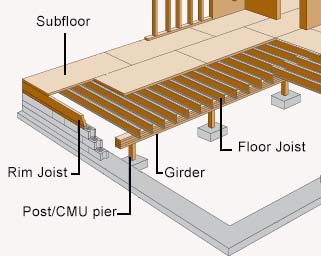Bouncy Floors Due To Termites
Are Termites Eating Your Floor Joists For Lunch?
Three Categories of Termites
In the United States termites do more damage to homes on an annual basis than all the natural disasters added together. There are over 2,800 species of termites worldwide, but in the US we only have to worry about 45 species. Termites are divided into 3 general categories – subterranean, wetwood and drywood.
Formosan Termite
 Of the three general categories of termites the subterranean termite is responsible for most of the damage done to homes in the United States. The most dangerous termite is the Formosan, nicknamed the super-termite. Their nests are underground and build mud tunnels to reach food sources like your floor joists, rim joists, plywood or particle board subfloors and generally prefer the softwoods your home’s structural components are made from. The Formosan termites have been know to destroy wooden structures within 30 days!
Of the three general categories of termites the subterranean termite is responsible for most of the damage done to homes in the United States. The most dangerous termite is the Formosan, nicknamed the super-termite. Their nests are underground and build mud tunnels to reach food sources like your floor joists, rim joists, plywood or particle board subfloors and generally prefer the softwoods your home’s structural components are made from. The Formosan termites have been know to destroy wooden structures within 30 days!
How Termites Cause Bouncy Floors
Let’s take a look at how your home’s structural foundation is put together to find out how termite damage can cause bouncy floors. Here is a diagram of the typical home’s wooden structural components.

If your home is infested with termites, the post, rim joist, floor joists and subfloor are the perfect food for termites. From the soil the termites can create tubes to your home’s support posts or rim joists and advance eating their way into your home’s floor joists and subfloor. If not stopped, they can continue into your home’s walls, flooring (if you have hardwood floors) and into your roofing structure.

When infested the wooden structures become honeycombed with termite tunnels. At this point the wood has lost the ability to support the attached subfloor and flooring above it. When a number of the floor joists become infested or a floor joist has severely been attacked by termites the supported floor feels spongy or bouncy due to the lack of support under the floor.
How To Fix Bouncy Floors Caused From Termite Damage
When you call CCSS, you can rest assured that your termite floor problem will be solved completely with the materials best suited for the job at the best pricing.
The first step is to identify if the termites are still actively attacking your home. If so, we will suggest you contact a professional pest control contractor to eliminate the active termite infestation.
 After the termite infestation has been taken care of by the pest control contractor, we will evaluate the condition of all the wooden structural supporting elements. If damaged beyond repair the pieces will be marked for replacement. If the wooden structural integrity is intact we will evaluate the possibility of saving the entire or partial parts of the structural element and reinforcing by a process called “sistering“.
After the termite infestation has been taken care of by the pest control contractor, we will evaluate the condition of all the wooden structural supporting elements. If damaged beyond repair the pieces will be marked for replacement. If the wooden structural integrity is intact we will evaluate the possibility of saving the entire or partial parts of the structural element and reinforcing by a process called “sistering“.
When we encounter a major termite problems we rely on our network of certified structural engineers to validate and sometimes help design the repairs necessary. Those designs may incorporate steel to replace the damaged wooden support elements or possibly rebuilding, replacing or adding support piers with CMU piers (CMU = concrete masonry unit).
We have over 25+ years of experience in the crawl space and foundation repair business. We’ve seen and fixed all residential or commercial problems without over-engineering, over-stuffing or over-charging. We would recommend using us as a second opinion when dealing with the large, franchise dealers … you will be pleasantly surprised as many of our customers were. Call us first or call us last … your wallet will love us!

